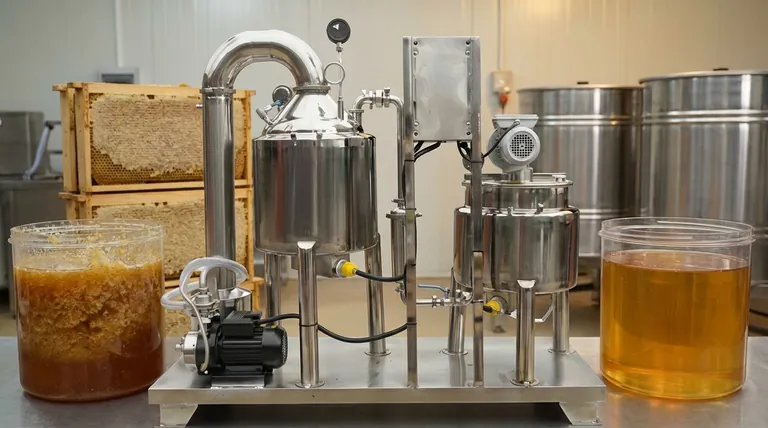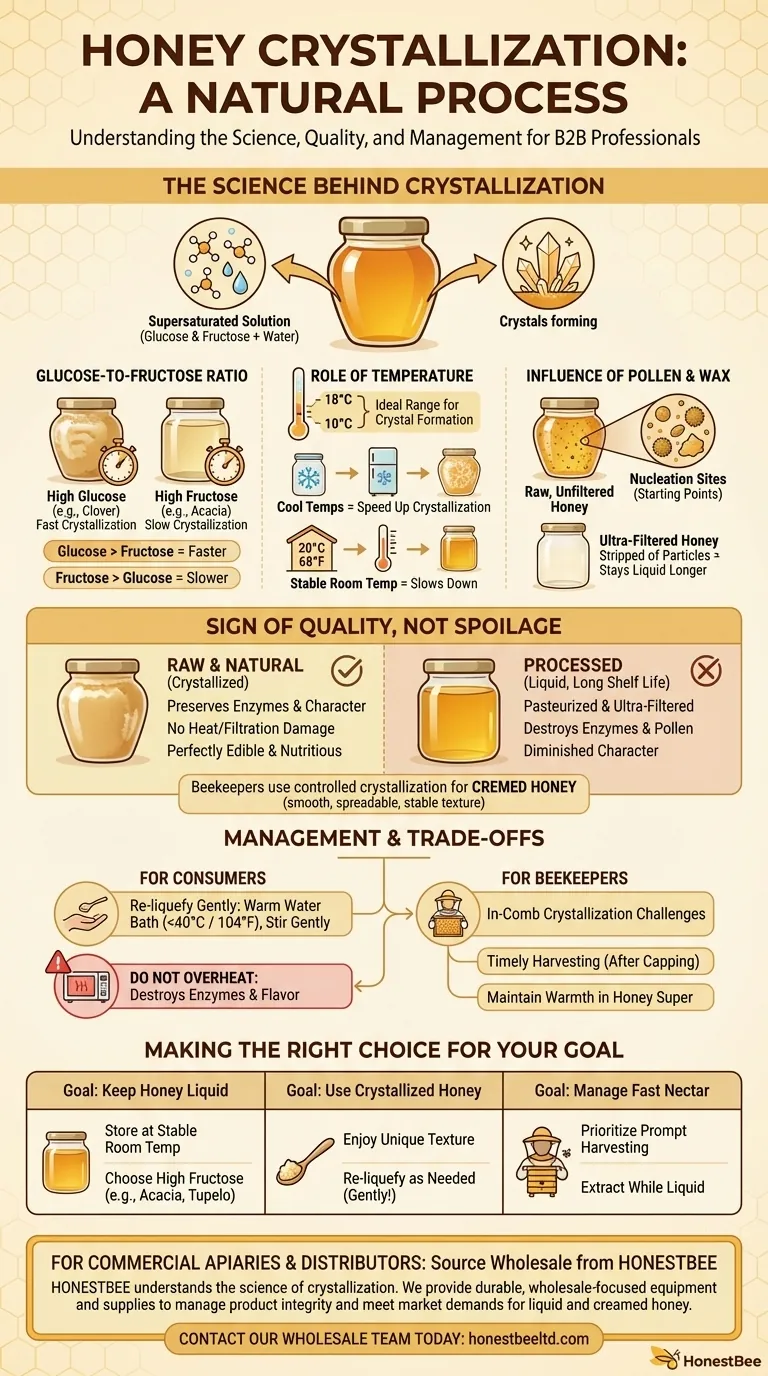Contrary to what many assume, honey crystallization is not a sign of spoilage or poor quality. It is a completely natural process where the glucose in honey separates from the water and forms sugar crystals, and it will eventually happen to almost all types of pure, raw honey. In fact, crystallization is often an indicator that your honey is natural and has not been heavily processed.
The tendency for honey to crystallize is governed primarily by its specific glucose-to-fructose ratio and the temperature at which it's stored. Understanding this allows you to manage its texture, not fear its natural state.

The Science Behind Crystallization
To truly understand why honey crystallizes, you must see it for what it is: a supersaturated solution of sugars, primarily glucose and fructose, in a small amount of water. This delicate balance is easily disrupted.
The Glucose and Fructose Ratio
The single most important factor is the ratio of the two main sugars. Glucose is less soluble in water than fructose.
Therefore, honey with a higher percentage of glucose will crystallize much more quickly. For example, honey from clover or dandelion is high in glucose and solidifies rapidly. Conversely, honey like Tupelo or Acacia is high in fructose and can remain liquid for years.
The Role of Temperature
Temperature acts as the catalyst for crystallization. The ideal temperature range for crystals to form is between 10°C and 18°C (50°F and 65°F).
This is why putting honey in a cool pantry or refrigerator will actually speed up crystallization, not prevent it. Storing honey at a stable room temperature (above 20°C / 68°F) is more effective at keeping it liquid.
The Influence of Pollen and Wax
Raw, unfiltered honey contains microscopic particles of pollen, propolis, and beeswax. These particles act as nucleation sites, or starting points, upon which the glucose crystals can begin to form.
This is a key reason why highly processed, ultra-filtered honey found in many supermarkets stays liquid for so long—the very particles that serve as crystallization seeds have been stripped out.
Crystallization is a Sign of Quality, Not Spoilage
In a market filled with processed foods, the crystallization of honey should be viewed as a positive attribute. It signifies a natural product that has not been subjected to treatments that diminish its character.
Distinguishing Natural from Processed Honey
Large-scale honey producers often pasteurize (heat) and ultra-filter their honey. This destroys beneficial enzymes and removes all pollen.
While this process creates a visually appealing, consistently liquid product with a long shelf life, it also removes many of the unique characteristics and potential health benefits associated with raw honey.
The Value of Crystallized Honey
Crystallized honey is still perfectly edible and retains all of its original flavor and nutritional value. The only thing that changes is the texture.
In fact, some beekeepers intentionally induce controlled crystallization to produce creamed or spun honey. This creates a smooth, spreadable product that is prized for its texture and will not revert to a liquid at room temperature.
Understanding the Management and Trade-offs
Whether you are a consumer with a jar in your kitchen or a beekeeper managing frames, crystallization is a characteristic to be managed, not a problem to be fixed.
For the Consumer: How to Re-liquefy Honey
If you prefer your honey in a liquid state, the process is simple. Place the jar in a warm water bath and stir it gently as the crystals dissolve.
Crucially, do not use a microwave or overheat the honey. Exposing honey to high temperatures (above 40°C / 104°F) will destroy its delicate enzymes and can alter its flavor profile. Gentle warmth is all that is required.
For the Beekeeper: Preventing Crystallization in the Comb
For beekeepers, honey that crystallizes in the comb can be a significant challenge, making it difficult or impossible to extract. This is especially true with certain nectar sources like canola.
Managing this involves timely harvesting—extracting the honey soon after the bees have capped it. Maintaining warmth in the honey super, often aided by heat rising from the brood box below, can also help delay crystallization before you have a chance to harvest.
Making the Right Choice for Your Goal
Your approach to crystallization depends entirely on your objective. It is a feature of natural honey, not a flaw.
- If your primary focus is keeping honey liquid for as long as possible: Store it at a stable room temperature (not in a cool pantry) and choose honey varieties known for a high fructose content, such as Tupelo, Acacia, or Sage.
- If your primary focus is using crystallized honey: Enjoy its unique, sugary texture as a spread or simply re-liquefy it by gently warming the jar in a water bath.
- If you are a beekeeper dealing with fast-crystallizing nectar: Prioritize prompt harvesting as soon as the frames are capped to ensure you can extract the honey while it is still liquid.
Ultimately, understanding crystallization transforms it from a perceived defect into a predictable and manageable characteristic of authentic, natural honey.
Summary Table:
| Factor | Effect on Crystallization |
|---|---|
| Glucose-to-Fructose Ratio | High glucose (e.g., Clover) = Fast crystallization. High fructose (e.g., Acacia) = Slow crystallization. |
| Storage Temperature | Ideal range: 10°C-18°C (50°F-65°F). Cool temperatures speed it up; stable room temp slows it down. |
| Pollen & Wax Particles | Present in raw honey, they act as seeds for crystal formation. Ultra-filtered honey lacks these and stays liquid longer. |
| Heating/Processing | Pasteurization and ultra-filtration prevent crystallization but remove natural enzymes and pollen. |
For Commercial Apiaries & Distributors: Source Wholesale Honey & Beekeeping Supplies from HONESTBEE
As a commercial beekeeper or equipment distributor, managing honey quality and consistency is paramount. HONESTBEE understands the science behind crystallization and supplies the durable equipment and supplies you need to manage it effectively—from extraction to storage. We provide wholesale-focused solutions to help you maintain product integrity and meet market demands for both liquid and creamed honey.
Let's discuss your specific needs. Contact our wholesale team today to get reliable, high-volume beekeeping supplies.
Visual Guide

Related Products
- 0.5T Capacity Honey Dehumidifier Dryer with Vacuum Heating and Thickening Filtering Machine
- 6 Frame Manual Stainless Steel Honey Extractor Beekeeping Equipment
- HONESTBEE 72 Frame Industrial Electric Honey Extractor for Beekeeping
- 24 Frame Honey Extractor Commercial Radial Honey Frame Extraction Machine
- HONESTBEE 3-Frame Manual Acrylic Honey Extractor
People Also Ask
- How to reduce moisture level in honey? Preserve Quality and Prevent Fermentation
- How much honey can a honey dryer process and by what percentage does it reduce moisture? Optimize Your Honey Production
- What are the advantages of a condensation honey dryer? Boost Quality & Yield for Your Apiary
- How to extract uncapped honey? Salvage Your Harvest and Prevent Fermentation
- What is the recommended drying temperature and moisture content for honey? Preserve Quality & Prevent Fermentation



















